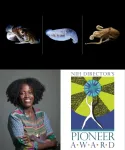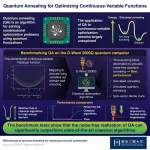(Press-News.org) The ability to have access to the Internet or use a mobile phone anywhere in the world is taken more and more for granted, but the brightness of Internet and telecommunications satellites that enable global communications networks could pose problems for ground-based astronomy. University of Illinois Urbana-Champaign aerospace engineer Siegfried Eggl coordinated an international study confirming recently deployed satellites are as bright as stars seen by the unaided eye.
“From our observations, we learned that AST Space Mobile’s BlueWalker 3—a constellation prototype satellite featuring a roughly 700 square-foot phased-array antenna—reached a peak brightness of magnitude 0.4, making it one of the brightest objects in the night sky,” Eggl said. “Although this is record breaking, the satellite itself is not our only concern. The untracked Launch Vehicle Adapter had an apparent visual magnitude of 5.5, which is also brighter than the International Astronomical Union recommendation of magnitude 7.”
For comparison, the brightness of the stars we can see with an unaided eye is between minus 1 and 6 magnitude, minus 1 being the brightest. Sirius, the brightest star, is minus 1. Planets like Venus can sometimes be a bit brighter--closer to minus 4, but the faintest stars we can see are roughly magnitude 6.
Watch a video showing a starry sky with three satellites: BlueWalker 3 at 19:52:45, 19:52:56, 19:53:18, 19:53:29; Starlink-4781 is visible at 19:52:54 and 19:53:26, leading BlueWalker 3; Starlink-4016 is parallel and slightly behind BlueWalker 3 at 19:53:34. Video courtesy: Marco Langbroek, Delft Technical University.
“One might think if there are bright stars, a few more bright satellites won't make a difference. But several companies plan to launch constellations,” Eggl said. “For example, Starlink already has permission to launch thousands of satellites, but they’ll probably get their full request of tens of thousands granted eventually.
“And that’s just one constellation of satellites. Europe and China want their own constellations and so does Russia. Just those in the United States being negotiated with the FCC amount to 400,000 satellites being launched in the near future. There are only 1,000 stars you can see with the unaided eye. Adding 400,000 bright satellites that move could completely change the night sky.”
Eggl is a member of the International Astronomical Union Centre for the Protection of the Dark and Quiet Sky from Satellite Constellation Interference, IAU.
“BlueWalker 3 is so bright that most of the big telescopes such as the Rubin Observatory believe it could obliterate large parts of exposures,” Eggl said. “They already have to avoid observing Mars and Venus for the same reason, but we know where the planets are so we can dodge them. We cannot accurately predict where all the satellites will be years in advance. Just accepting recurring data loss in multi-billion-dollar observatories is not an option either.”
He said although satellites won't necessarily damage the telescope’s CCDs, or charge-coupled devices, they will still cause data loss from the streaks. Extremely bright satellites could ruin the entire field of view, like trying to stargaze when someone periodically shines a flashlight into your eyes.
Eggl said several solutions to the problem are being explored in collaboration with the Laboratory for Advanced Space Systems at Illinois and satellite operators such as SpaceX.
“Starlink is looking at making their satellites’ surfaces darker, which absorbs more and reflects less visible sunlight. But the absorption generates heat. The satellites then have to emit infrared light which means observations in optical wavelengths don’t have as large of a problem, but infrared observations might. And heat is one of the biggest engineering problems that we have in space. So, painting everything black comes with repercussions,” he said.
Another idea from SpaceX is to make satellites’ solar panels more reflective with dielectric mirrors. The mirrors allow the satellites to change the direction of the reflection so that it’s not pointing directly at the Earth.
“If SpaceX can make the solar panels point in a different direction to avoid glints, or use these mirror tricks, they might solve a lot of the problems we have with the optical flaring of Starlink satellites,” Eggl said. “With other providers, it’s not quite as easy. AST has gigantic satellites, with hundreds of square feet of electronic phased arrays, that they need to communicate with cell phones on the ground. If they made satellites smaller more of their radio signals would leak out through so-called ‘side lobes’ potentially affecting radio astronomy sites.
Eggl said AST also prefers to keep the satellite pointed toward the surface of the Earth to achieve maximum efficiency. Starlink solutions may not easily translate to AST satellites and new mitigation strategies are needed.
“We are trying to work with the space industry, where possible,” he said. “We want to solve this together so it’s a collaborative effort that everybody can sign onto because that's the fastest route to get things done.”
The study, “Optical observations of an ultrabright constellation satellite,” was written by Sangeetha Nandakumar, Siegfried Eggl, Jeremy Tregloan-Reed, et al. It is published in the journal Nature. DOI:10.1038/s41586-023-06672-7
Ph.D. student Nandakumar analyzed the data for this first international study to be published from the center. Nandakumar works with Jeremy Tregloan-Reed at the Universidad de Atacama in Chile.
END
Study quantifies satellite brightness, challenges ground-based astronomy
2023-10-03
ELSE PRESS RELEASES FROM THIS DATE:
AI combines chest X-rays with patient data to improve diagnosis
2023-10-03
OAK BROOK, Ill. – A new artificial intelligence (AI) model combines imaging information with clinical patient data to improve diagnostic performance on chest X-rays, according to a study published in Radiology, a journal of the Radiological Society of North America (RSNA).
Clinicians consider both imaging and non-imaging data when diagnosing diseases. However, current AI-based approaches are tailored to solve tasks with only one type of data at a time.
Transformer-based neural networks, a relatively new class of AI models, have the ability to combine imaging and ...
Large NIH grant supports CRISPR-based gene therapy development for brain diseases
2023-10-03
A two-phase NIH grant will fund research into a new CRISPR-based gene therapy platform that will target genetic brain diseases like Angelman syndrome and H1-4 (HIST1H1E) syndrome.
A roughly $40 million National Institutes of Health (NIH) grant awarded to Yale School of Medicine will support the development of a gene-editing platform technology capable of reaching the human brain. The innovative new genome-editing technology, which was developed from the first phase from NIH Common Fund Somatic Cell Genome Editing (SCGE) program, could potentially lead to treatments or cures for many neurogenetic diseases.
Neurogenetic disorders ...
Bursts of star formation explain mysterious brightness at cosmic dawn
2023-10-03
When scientists viewed the James Webb Space Telescope’s (JWST) first images of the universe’s earliest galaxies, they were shocked. The young galaxies appeared too bright, too massive and too mature to have formed so soon after the Big Bang. It would be like an infant growing into an adult within just a couple years.
The startling discovery even caused some physicists to question the standard model of cosmology, wondering whether or not it should be upended.
Using new simulations, a Northwestern University-led ...
Van Andel Institute scientist awarded $2.9 million to tackle insulin resistance, a driver of Type 2 diabetes
2023-10-03
Van Andel Institute’s Nick Burton, Ph.D., has earned a five-year, nearly $2.9 million New Innovator Award from the National Institutes of Health Common Fund to find new ways to fix or prevent insulin resistance, a key driver of Type 2 diabetes.
Although manageable with treatment, there currently is no way to repair the underlying mechanisms that cause the disease. Furthermore, it remains unclear why some people are more prone to Type 2 diabetes while others are resistant. To find a solution, Burton ...
SwRI study suggests large mound structures on Kuiper belt object Arrokoth may have common origin
2023-10-03
SAN ANTONIO — October 3, 2023 —A new study led by Southwest Research Institute (SwRI) Planetary Scientist and Associate Vice President Dr. Alan Stern posits that the large, approximately 5-kilometer-long mounds that dominate the appearance of the larger lobe of the pristine Kuiper Belt object Arrokoth are similar enough to suggest a common origin. The SwRI study suggests that these “building blocks” could guide further work on planetesimal formational models. Stern presented these findings this week ...
Marine chemical biologist Mandë Holford wins prestigious National Institutes of Health Pioneer Award for Venom Research
2023-10-03
NEW YORK, Oct. 3, 2023 — Mandë Holford, a professor in the Chemistry and Biochemistry departments at Hunter College and The City University of New York Graduate Center (CUNY Graduate Center), has won a National Institutes of Health Common Fund Pioneer Award for her trailblazing research exploring the therapeutic opportunities and properties of venoms from cephalopods and other marine mollusks. Holford received one of eight Pioneer Awards granted in 2023, which will total more than $47.7 million over five years.
This is the first time a CUNY ...
Synthetic peptide could reduce vascular problems associated with COVID-ARDS
2023-10-03
AUGUSTA, Ga. (Oct. 4, 2022) – A synthetic peptide developed by researchers at the Medical College of Georgia could help reduce vascular problems associated with acute respiratory distress syndrome in COVID-19.
In severe cases, COVID-19 is associated with the syndrome, which happens when fluid builds up in the tiny, elastic air sacs in the lungs, keeping them from filling with enough air and keeping oxygen from reaching the bloodstream. “These are the people who get the sickest from ...
Cardiology compensation and production remain relatively stable year-over-year
2023-10-03
MedAxiom, the premier source for cardiovascular organizational performance solutions, has released its 2023 Cardiovascular Provider Compensation and Production Survey Report that includes data from the largest number of providers since its debut. The report features a foreword from MedAxiom President and CEO Jerry Blackwell, MD, MBA, FACC, on the consistency of year-over-year data from 2021 to 2022, the importance of a robust pool of data to form the foundation of the report, and the application of data as a strategic planning tool.
2023 Report Highlights:
Compensation and production ...
Optimizing continuous-variable functions with quantum annealing
2023-10-03
Quantum annealing (QA) is a cutting-edge algorithm that leverages the unique properties of quantum computing to tackle complex combinatorial optimization problems (a class of mathematical problems dealing with discrete-variable functions). Quantum computers use the rules of quantum physics to solve such problems potentially faster than classical computers. In essence, they can explore multiple solutions to a problem simultaneously, giving them a significant speed advantage for certain tasks over classical computers. In particular, QA harnesses the phenomenon of “quantum ...
City of Hope opens first U.S. multicenter clinical trial for robotic single-port mastectomies for breast cancer patients
2023-10-03
LOS ANGELES — City of Hope, one of the largest cancer research and treatment organizations in the United States, is opening a multicenter clinical trial to evaluate the efficacy of robotic-assisted, single-incision mastectomies. The minimally invasive procedure, which preserves the nipple and leaves only a small hidden scar on the side of the body, could potentially lead to significant improvements for breast surgery.
“City of Hope is once again taking the lead in investigating innovations, treatments and therapies that are making big leaps forward for patients with cancer. We’re participating ...








